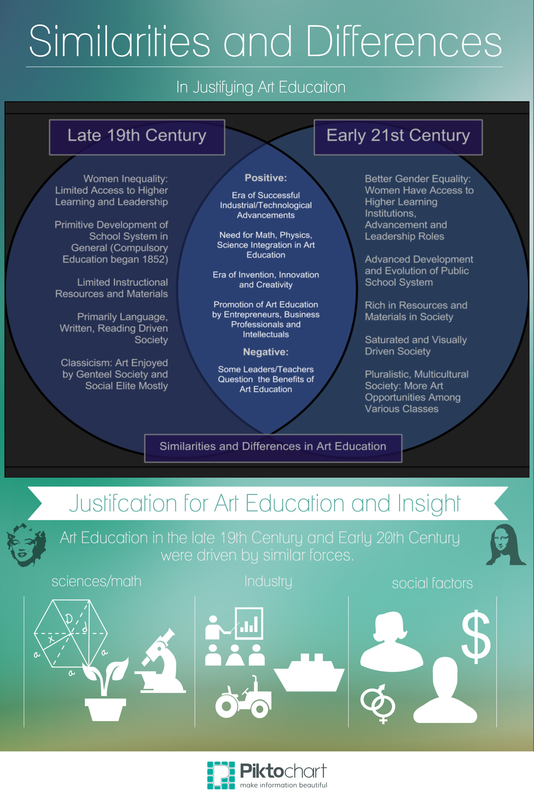|
This infographic and post are from a recent entry in the discussion forum for the: History of Teaching Art with Dr. Roland! University of Florida "Just as there were various rationales proposed for art education in nineteenth-century American schools, there are many current popular justifications for art education in our nation’s schools. What similarities and differences do you see in the ways art education’s place in schools has been justified in the two eras (late nineteenth-century and early twenty-first-century America) What insights can be gained by examining the various reasons for justifying art education place in the school curriculum?" The Basic Need
In the late 19th century and early 21st century similar justifications exist for the inclusion of art education in the school system. In both centuries, because of the driving force of science, technology and industry, drawing and art education was and is essential in helping Americans keep up with developing technological and industrial advancements worldwide. Drawing and art education provide people with essential skills that can be applied to other professions. Students gain insight in enhanced observation and motor skill technique and improve their understanding of physics, engineering concepts and visualization. Developing eye hand coordination through artistic practice is beneficial in many areas of life. The enriching qualities of learning drawing and art help individuals open up understanding about life around them and discover applications for solving real world problems. In the 19th century, Walter Smith saw the importance of art for industrial growth and a skilled labor force in America (Stankiewicz, 2001). Like other affluent societal leaders, entrepreneur Louis Prang saw art as a way to improve upon societies’ understanding of artistic practice and appreciation. In addition to wanting more American skilled workers employed in his lithography business, Prang also looked towards a future of procuring sales from more educated art connoisseurs (Stankiewicz, 2001, p. 15). Still others in psychology and science saw the enriching qualities of art, promoting art education as a way to better see the world around us, express our inner thoughts and in some cases experience God’s creation more intimately through keen observation (Stankiewicz, 2001). Also in the 19th century, women played an important role in developing art education practices, however, they were granted limited access in, leadership, the workforce and in higher educational institutions. Although issues of classicism in general and discrimination against women predominated, pioneers like Mary Ann Dwight, Emma Willard and Mary Dana Hicks Prang persevered in laying foundational work while introducing and promoting art education within the schools (Stankiewicz, 2001). The developments regarding industry and society in both centuries offer very distinct similarities. The justification for art in schools was driven by science, industry, psychological and even natural or agricultural fields of study. One major difference evident in the late 19th century is that art for art sake had yet to come of age in the school system. Currently we are experiencing a new era of innovation, one that may be unprecedented before in history. This renaissance is more integrated and inclusive. We see justifications for art in schools as in times past. Most based on the needs and collective works between artists and highly skilled professionals. However, the lines that separate artists from other fields of study are becoming more blurred along the way. This resurging need for art education is due to evolved understandings about life, advancements in industry, technology, innovation, creativity and science. In much the same way as the late 19th century, art is helping progress. However, this time art, society and industry are driving towards a more high tech, virtual and digital lifestyle. Early 21st century agencies like Ted Talks and educational institutions like M.I.T. promote art’s integration into other areas of living and profession. Steve Jobs decidedly made design and function two of the most important facets of Apple products, both essential in art creation and engineering. Socially our world is much different, we have become centered on imagery, visually driven and society is more humanistic in nature. Art education has continued to offer enriching qualities of experience then and now. This time around, art education is more readily available and with the image saturated world we live in. Art has much more presence in our everyday lives than in centuries past. Overall, art education has been and is driven by need; however, I propose that art itself is an essential need in all of us. We play, we arrange and we create. We look to see and we learn to draw. We experience the wonder of nature and the wonder of creation, by God and by man. In all of this, art education plays a major role. It is true in our advancements as a society, as individuals, educators and as artists. Stankiewicz, M. A. (2001). Roots of art education practice. Worcester, MA: Davis Publications.
0 Comments
Leave a Reply. |
Scott HughesArt Educator, Professional Photographer, Journalist. Alumni: Archives
March 2020
Categories
All
|

 RSS Feed
RSS Feed